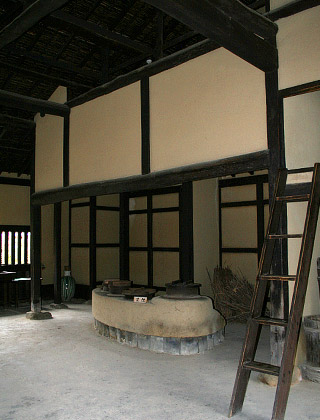|
||
 |
||

Old Kometani ÄJ houseiNara)
@
(C)2001 Japanese Architecture and Art Net Users System.@No reproduction or republication without written permission.
fÚÌeLXgEÊ^ECXgÈÇASÄÌRec̳f¡»E]ÚðֶܷB
|
||||||
| @ | ||||||
| kamaya@® | ||||||
| KEY WORD :@architecture / folk dwellings | ||||||
| @ | ||||||
| Also
written â}®. Lit. cooking room. Either refers to a freestanding structure
used for cooking, or a part of a vernacular house *minka
¯Æ, used for cooking. The term was already in use in temples of the Nara
period to mean a building used for cooking, especially boiling rice.
It had one or more cauldrons kama , and cooking ranges *kamado
â}. In Edo period minka in various parts of Japan including Chiba,
Okayama, Shimane and Kagawa prefectures, a free-standing structure that
stood either to the lower end *shimote
ºè, of the main house, or behind the earth-floored area *doma
yÔ. The kamaya had a hard-packed floor and contained a cooking range.
In many parts of Japan, the kamaya referred to an area used for cooking,
where the cooking range was situated. It was usually a part of the earth-floored
area, towards the rear of the house. In minka in Shikoku l, and
parts of Okayama, Tokyo and Yamaguchi prefectures, the kamaya was
an earth-floored area which projected from the rear of the main house *hon'ya
{®, either in the form of a penthouse structure *geya
º®, or forming a T-shaped or L-shaped plan tsunoya p®. Again, this
was used for food preparation and contained a cooking range. In Tokushima
prefectures, it was also called kamaba ê. In minka in the Nara and
Osaka areas, the kamaya was an extension of the earth-floored area
at the lower end. It contained a sink, nagashi µ, in addition to
the cooking range. In houses with a *yamatomune
åa style roof, the tiled roof of the kamaya was often lower than
that of the main thatched part, and was provided with a smoke louvre *kemuridashi
o. In vernacular houses in parts of Yamanashi prefecture, the kamaya
referred to a low timber platform projecting into the rear part of the earth-floored
area doma. In divided-ridge
type farmhouses *buntougata
ª^ of the Edo period in Honshuu {B, kamaya was the most common
term used to refer to the structure that covered the earth-floored area.
It directly abutted the raised-floor living structure kyoshitsubu
º. A valley gutter *toi
ó, was generally constructed at the interface between the two buildings.
The kamaya usually had a hipped roof *yosemune
yane ñ®ª, covered with thatch, contained a cooking range, and served
as a cooking area and an indoor working area. In some cases it also incorporated
a stable *umaya n®.
|
||||||
| @ | ||||||
 Old Kometani ÄJ houseiNara) |
||||||
@ |
||||||
| REFERENCES: | ||||||
| *kamadono a | ||||||
| EXTERNAL LINKS: | ||||||
| @@ | ||||||
| NOTES: | ||||||
| @ | ||||||
(C)2001 Japanese Architecture and Art Net Users System.@No reproduction or republication without written permission. fÚÌeLXgEÊ^ECXgÈÇASÄÌRec̳f¡»E]ÚðֶܷB |
||||||
| @ |